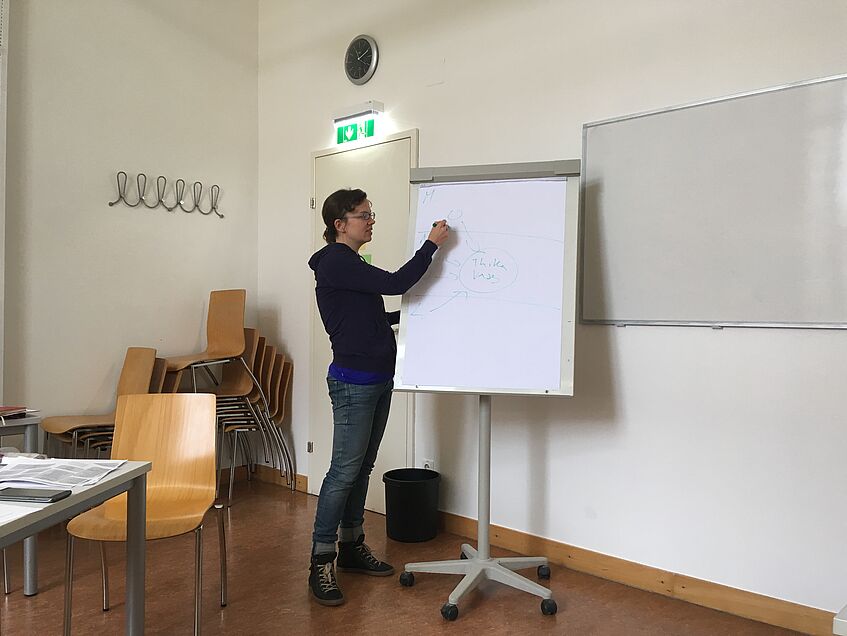Archival encounters

Martina Barker-Ciganikova,
© Daniela Waldburger.
Archival encounters
Martina Barker-Ciganikova
Halftime in our project, one year after our opening workshop and with a number of research stays behind us, piles of excerpted and even higher piles of unprocessed data lying on our work desks, we felt a certain urge to exchange our experiences on our archival encountersand approaches in some depth. On 7 December 2018, we thus organized an internal workshop on categorization, organization and order of archival sources and materials. Throughout the initial stage of our research project,we gathered a plethora of primary archival data relevant to our respective case studies from a number of archives. These include: The National Archives in Kew, UK, the Archives of the Union Minière du Haut-Katanga in the State Archives in Brussels, Belgium, The Zambia National Archives in Lusaka, and the Kenya National Archives in Nairobi.
A number of key questions and selected secondary literature guided us through the process: what strategies to use for organizing archival data? How to make sense of archival materials and how to uncover patterns and relationships within the records we so assiduously obtained? How to distinguish between the important and the unimportant? Can our data ever be complete or are we doomed to partial, incomplete fragments of our subject interest? Where do our personal experiences, assumptions and convictions come in and how do they help us in compiling the dataset? When drawing parallels and making comparisons between our case studies, shall we try to identify the anomalies and gaps or rather the patterns and the obvious? As we progressed through the day, the number of questions kept growing without necessarily finding a definite answer for any one of them.
Notwithstanding the many loose ends, we were able to find some common ground and to identify, even if preliminary, significant commonalities that provide a basisfor our future research. Emerging out of the fruitful discussions, I would like to highlight three relevant points. Firstly, we realized that the relationship between our archival data and the published secondary sources is reciprocal and constantly evolves. Through the questions generated by the archival material,we (re)discoveredpublished literature or reread the already known with new eyes and the seemingly familiar words gained new, till then unthought-of connotations. We also found it a particularly enriching experience to “switch” between the “metropolitan” and the “colonial” archives to see how the individual documents, files and sources feed into and complement each other.
Secondly, we became even more conscious of the importance of reading not only along, but also “against the grain” of the archival colonial order of things. Along which criteria do we restructure our files if we do not intend to follow a certain archival colonial logic of order? Encounter(s) became a central concept framing our discussions: encounters with the material, encounters with the archives, and probably most importantly,encounters with ourselves as researchers and compilers. We also discussed the ‘archive’ as embedded within its several meanings: as a physical structure, as an institution, as a source, as a subject, as a corpus of selected files, as a body of stored and ordered knowledge, as a working space, as a process of friction through which categories of knowledge get established. We found that to understand the archive in all its complexity, we need to take account of all its facets.
Thirdly, it felt reassuring to find out, thanks to our exchanges but also available secondary literature, that seemingly all researchers fight with a similar set of challenges while conducting archival work. Be it taking imposed order for granted, falling victim to possible fabrication, not realizing what is missing, or simply not understanding the past at all. An important insight was that our records on the post-colonial housing situations have become significantly thinner and we will have to put together additional sets of sources from other venues or stores if we conceive of housing policies and practices as a continuum across the colonial/post-colonial divide. The process is far from complete. As we engage with our data, we keep discovering new sets of thematic nodes and clusters around which we (re)order the archival order. As we are an interdisciplinary group working on three separate, yet interlinked, case studies, we constantly try to keep in mind the individual pieces and fragments we encounter with regard to the other respective case studies. Doing so, we hope to establish not only individual thematic nodes, but a whole structure linking the nodes, and our case studies, together.
December, 2018
